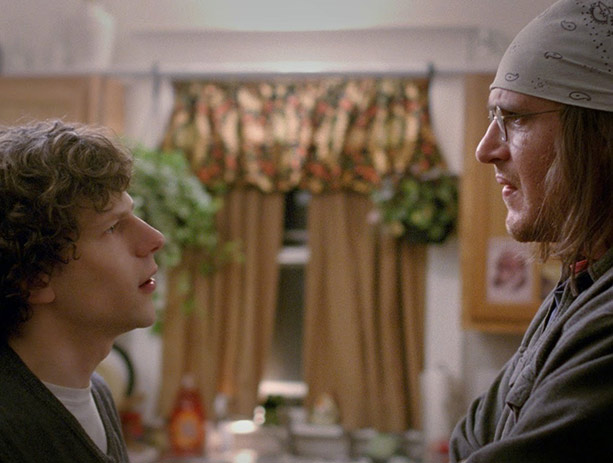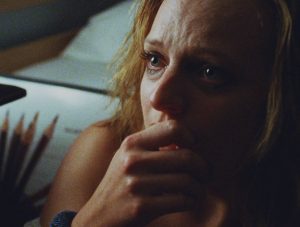Three Must-See Summer Movies

Kurt Brokaw recommends three films from Brooklyn's BAMcinemaFest.
Senior critic, Kurt Brokaw, culled this year’s BAMcinemaFest line-up for three summer films to add to your must-see list.
The End of the Tour
(James Ponsoldt. 2015. USA. 105 min.)
The “tour” in this super sophisticated, high-falutin’ dissection of author David Foster Wallace’s life refers to the last five-day leg of a book tour from Illinois to Minnesota in the winter of 1996. Wallace was celebrating the publication of his second novel, the 1,079 page Infinite Jest (hardcover weight, three pounds four ounces), a book that erudite readers and pre-Internet hipsters were already comparing to James Joyce’s Ulysses (which Wallace’s parents read to each other out loud when he was a child).
Accompanying Wallace was Rolling Stone reporter David Lipsky, who’d successfully pitched his editor on the magazine’s first in-depth look at a “rock star writer.” Lipsky had been entranced with Wallace’s mammoth odyssey of 21st century corporate America—a society that made adult Depends the year’s premiere product. The two leading protagonists, wading through this morass of junk-branding are Hal, a tennis pro in a Boston sports center, and Don, a cross-addicted alcoholic and recovering Demerol addict, who are locked in a search for the negative to a movie that causes death when viewed. That’s your Twitter-length summary of Infinite Jest. (The novel contains over a hundred pages of just footnotes and endnotes; you’ll be excused for reading it on a Kindle on the subway.)
Lipsky may have sensed that Wallace could grow into a kind of highbrow replacement for Kurt Cobain. Nirvana’s singer/songwriter/guitarist had sold 75 million records and was similarly being hailed as “a spokesman for a generation” before overdosing in 1994 on enough heroin to kill three addicts, and then, insuring he’d die, with a shotgun blast to his head. Part of Lipsky’s mission was to plumb the inner Wallace—a longhaired mountain of a man who piled on layers of mismatched clothes like armor and wore smudged glasses beneath signature headbands that absorbed his sweat (though some wags said the headbands were to keep his big brain from falling out).
The road trip would reveal how Wallace, unlike Cobain, would handle (at least for a while) the big time fame he seemed to resist even as he acknowledged and committed to its trappings—like agreeing to share room and board for an entire week with a national magazine reporter holding a tape recorder. Wallace had told an earlier interviewer, “I’m an exhibitionist who wants to hide, but I’m unsuccessful at hiding; therefore, somehow I succeed.” He was an uneasy captive to what he called “the greasy thrill of fame.”
The reporter had surely researched Wallace’s early life enough to know about his substance abuse history. As an undergrad at Amherst in the early 80s, Wallace had been diagnosed with depression and started what would become 20 years of dependence on the anti-depressant Nardil. In 1989, after years as a pothead and barely functioning alcoholic, and twice attempting suicide, he went into McLean Hospital, Harvard’s top psychiatric hospital. He was released after 28 days into a halfway house in nearby Brighton, where he continued writing much of Infinite Jest, basing Don (and a lot of other church-going types in the novel) on cross-addicted alcoholics like himself and their 12-step recovery meetings.
One of Wallace’s most significant relationships was with the author/poet Mary Karr, who was married. D.T. Max compares their relationship to the line in The Great Gatsby about how a bad driver is safe until he meets another bad driver (“Mary was that driver. And they were both newly sober.”) Wallace had her name tattooed on his arm, proposed marriage, and was violently jealous of her husband.
Another Wallace romance was with a political science professor at Illinois State University where he taught, which ended with his 67-page breakup letter. He became the quintessential author with the roaming eye, the millennial’s Philip Roth, freely admitting any number of one-night stands. When a fan asked him for his red bandanna, Wallace said he’d trade for the wearer’s Lucky Charms tee. His grad school writing students adored him, as he dressed like a logger and carried around chewing tobacco (he was a dipper) which he spat into a tin can. He gave one student a B for “32 instances of misplaced comma usage.” Though his hands sometimes shook, Wallace managed to stay off booze and dope, relying on Nardil to stabilize his daily life.
In 2006, after marrying the artist/poet Karen Green and moving to Claremont, California, he was teaching at Pomona when he suddenly stopped all prescription meds. His depression became acute and he tried electroconvulsive shock treatments. And then he committed suicide at his home in 2008. Was there a connection between ending his dependence on Nardil and ending his life? Writers, recovery professionals, and readers will forever be speculating on this. Wallace’s obituaries frequently referred to his goal to “communicate what it felt to be human or die trying.”
Knowing all this, you’re ready to watch and be immersed in The End of the Tour:
When the movie opens, Rolling Stone’s Lipsky has made his successful pitch to the magazine and flown out to Bloomington, where Wallace is living in a non-descript ranch house with his two dogs (Jeeves and Drone, named from the P.G. Wodehouse stories). Lipsky is played by Jesse Eisenberg, who’s certainly demonstrated he can be a forceful, commanding presence in The Social Network, Night Moves, and as the twin characters he plays in The Double.
Eisenberg forsakes that dominating persona here, even though he’s a published author and investigative reporter for a top magazine. He comes on as nervous, bashful, almost girlish in his dazzled adoration of his literary hero. “I want what you have,” he blurts, fumbling with his pocket recorder and making inane small talk. (Perhaps respecting his subject’s sobriety, he tells Wallace he doesn’t drink—until he does, cracking open a beer and maybe breaking his own sobriety date.)
Eisenberg looks like he’s genuinely enjoying playing second fiddle to a character who’s as smart about life as his own Mark Zuckerberg character was about technology in The Social Network. It’s Eisenberg shyly trotting out his feminine side as an actor, and it’s a risky, calculated interpretation of the role, because it tends to throw the entire movie into the six-foot-four-inch Jason Segal’s lap.
As David Foster Wallace, Segal gives a performance that’s unimaginably canny and staggering in its complexity. He quickly takes to the star-struck newsman, pouring out big chunks of his ambitions, philosophies and blocked visions in whole paragraphs. One of The End of the Tour’s many ironies is that its dense screenplay adaptation by the Pulitzer prize winner Don Margulies isn’t based on the reporter’s story—which Rolling Stone didn’t publish—but Lipsky’s 2010 book, Although of Course You End Up Being Yourself: A Road Trip with David Foster Wallace.
On the road and at Minneapolis’ gigantic Mall of America, The End of the Tour occasionally opens up its two-hander format to include Joan Cusack, Mamie Gummer and Mickey Sumner as his local driver and fans; Sumner appears to be a composite of Wallace’s girlfriends through the years, and when Lipsky innocently chats her up and flirts a bit, Wallace becomes intensely, ominously jealous. (This won’t track very well unless you know the Mary Karr connection.) There’s another scene in which Wallace gets on the phone for a lengthy conversation with Lipsky’s girlfriend (Anna Chlumsky) that ticks off the Stone reporter enough that he drinks, which also doesn’t figure given Lipsky’s all-worshipping character. But these are minor faults.
What counts is that as the tour progresses and the two men suss each other out, Wallace’s immense humanity—his proclivities for fast food, simple dancing, hours of being glued to a television set staring at bad movies—begins to match up with his known real-life attractions to his Illinois churches, to a steady diet of X-Files and Die Hard entertainment, to a plainspoken older couple whose wife he once flew to New York as a sounding board and grounding influence, to his fiercely loyal students wherever he taught. The movie is no more and no less than Wallace slowly releasing pieces of his dense philosophy, memories, and rudimentary life to a reporter, but it feeds us emotional rewards we’ll long remember.
“You can be shaped, or you can be broken,” Wallace wrote in Infinite Jest. “There is not much in between. Be coachable. Try to learn from everybody, especially those who fail. This is hard. How promising you are as a Student of the Game is a function of what you can pay attention to without running away.” Sometimes his loopy sentences collapsed into tiny, meticulously printed footnotes, but more often they snapped-to and formed profound truths that will ring true for generations to come.
Like the young woman in Wallace’s debut novel, The Broom of the System, who fretted she might be stuck forever as a character in a novel, Wallace was also, recognizably, a character in his own creations. He was a survivor longer than Kurt Cobain, who’d tasted, even previewed the blacked-out wrap of death, and was reporting back from the other side.
Queen of Earth
(Alex Ross Perry. 2015. USA. 90 min.)
Ingmar Bergman described his dark, intensely cinematic Persona (1966) as “beginning with the human face.” His two faces in that Swedish classic belong to Liv Ullmann, playing an actress who went mute in a performance of Electra, and Bibi Andersson, who acts Ullmann’s endlessly talkative nurse. Persona is set at a country house near the sea.
In the film, Bergman probes deep and deeper into the wounded female psyche, at one point tearing the screen image—the actual film stock—to convey the unbearable trauma and tension building between the two women. Rarely in cinema has suffering been so artfully executed. At another critical moment, the two halves of the women’s faces merge into one.

Queen of Earth similarly isolates two women in a summer home by a Hudson Valley lake, and it, too, begins with the human face—a screen-filling, anguished close-up of Elisabeth Moss (Catherine), a painter and assistant to her famous artist father, who’s suddenly died. On top of grieving over this loss, Catherine is angrily, almost hysterically severing ties with her lover.
It’s a long, harrowing near-monologue by Moss, and it cements her growing stature as a major American actress, instantly wiping away the seven years she labored along as Peggy, Mad Men’s lone female copywriter and creative supervisor on Madison Avenue in the 60s.
Shortly after her wrenching opening scene, Catherine arrives at the woodsy retreat owned by the parents of her friend, Ginny. She’s played by Katherine Waterston, 5’11” and willowy, her eyes critically drinking in and already evaluating her shaky visitor. Moss has come to heal, but writer/director Alex Ross Perry has other ideas.
At this point the two women are anchored into the same setting as Bergman’s Persona. Moss and Waterston certainly share character traits and, from some angles, physical appearances similar to Ullmann and Andersson, half a century ago.
Perry, an acute observer of contemporary relationships, wants to focus on Catherine’s relations to three men—her deceased father, her former lover, and a male neighbor of Ginny’s at the lake—and how their cumulative impact begins to distance the two women from each other. It’s a new millennium twist on Persona, and as you watch it unfold, you’re conscious how Perry is exploring the Persona dynamic in fresh, relevant ways. His decision to film in 16mm color gives the drama a faded palette that’s muted and somber—he might as well have shot in black-and-white like Bergman.
Perry’s film is divided into daily “chapters.” He confidently cross-cuts to flashbacks of the women at the lake house a year earlier, as Ginny fumes over the attention lavished by Catherine on her then-boyfriend James (Kentucker Audley). Meanwhile, in the present, a mirror image plays out: Catherine, slowly becoming more and more unhinged as she watches Ginny flirt with her neighbor Rich (Patrick Fugit).
Queen of Earth’s centerpiece scene—it’s a beauty, almost as mesmerizing as Andersson’s recollection in Persona of an afternoon when she gave herself on impulse to a teen boy on the beach and became pregnant—contains monologues by both women. The camera starts tight on Catherine, but gradually slides onto the face of Ginny, who’s intently watching her and listening without expression.
Ginny challenges Catherine to “trade roles and see how we feel,” which is Persona’s core premise, and as Catherine shuts down and falls apart, we see Perry is pointing his drama in the same direction as Ingmar Bergman once did. Like the unknowable Bibi Andersson, tall and severely brittle in Persona, Waterston is a shrewd and elliptical actress—she exudes the kind of privileged Westchester status you could smell and feel in the dark.
In Persona, Andersson slid a piece of broken glass onto a path where Ullmann would step on it. In Queen of Earth—well, that’s enough upfront comparisons for one appraisal. Suffice it to note that Perry’s new film is not quite as bitter and filled with repressed fury as Listen Up Philip, the director’s previous outing with the redoubtable Elizabeth Moss. This is a bigger, more fully mature drama, and if you’re going to be influenced by a world class artisan, Ingmar Bergman still trumps Philip Roth any night of the week.
Further reading on The Independent: Check out Dana Knight’s interview with Alex Ross Perry.
Tangerine
(Sean Baker. 2015. USA. 87 min.)
There’s a moment when Sean Baker’s aggressive and baleful dramedy of transgender prostitutes in Los Angeles transcends its tabloid environs and sputters into something approaching real art. It takes over half an hour to arrive (and you may be checking your watch more than once, wondering how you got trapped in this weird subculture), and it occurs in a car wash.

The taxi of Razmik (Karren Karagulian) is slowly moving through the wash, its interior shielded by cascading waterfalls. Razmik, a gruff Armenian immigrant who we’ve been patiently following as he picks up and drops off sundry fares along Santa Monica Blvd., suddenly drops his head into the lap of a trans pal hooker, Alexandra (the singer/performer Mya Taylor in a flamboyant feature film debut) for some finger-lickin’ paid sex. Then Razmik heads home to his wife, child, bossy mother-in-law and their Armenian friends for a Christmas night celebration. Welcome to the 2015 American Way of Life, LA style.
Razmik’s indiscretion is the audacious plot device that director Baker has been lying in wait to spring on us. Suddenly a subplot seemingly unrelated to the director’s unvarnished portrait of mixed sex hookers and their sad, drug-fuzzed johns has given his movie a jolt. It powers an increasingly urgent, unsettled and often very funny collision of cultures and morals.
The showdown occurs at Donut Time where Razmik’s mother-in-law, his wife, and their whiny daughter confront the cheating driver, along with Aly, plus the prostitute’s trans pal Sin-Dee (Kitana Kiki Rodriguez, also debuting), plus their pimp (James Ransone), plus another of his brood—a sullen, skinny, biological female (Mickey O’Hagan). It’s a bizarre ensemble of overlapping accusations, defenses, putdowns and lies, and it builds with all the farcical assurance of Edward Norton and his loony fellow actors doing Raymond Carver in Birdman. This is razor-sharp sketch comedy of a very high order, and Baker gives you permission to enjoy every minute of it. You’ve earned it; it’s your take-home reward.
Tangerine is going to influence young filmmakers globally as a pioneering feature film shot with mobile phones, including the Apple iPhone 5S, outfitted with a prototype anamorphic adapter. This opens up the screen to near CinemaScope proportions, which gives the bleak downtown LA streets around Highland and Santa Monica (where everyone drives and no one walks) an even emptier look. The sex workers ply their trade on corners, waiting for the occasional driver who’s eying the available goods. Mostly the city looks as dead as the shuttered movie palaces in Paul Schrader’s The Canyons.
Baker’s iPhone color images are satisfactory though not as robustly rich as the Canon EOS 7D used by Lena Dunham in Tiny Furniture and the Canon 5D2 Lou Reed chose in making his documentary short, Red Shirley. This probably doesn’t matter—the good news is that you can shoot your movie on a mobile phone while riding your bike, as thousands of budding filmmakers are itching to do. No wonder The New York Times is no longer guaranteeing reviews on every feature with a distributor that comes to town.
Director Baker also resurrects actor Clu Gulager in an early scene as one of Razmik’s fares. Gulager, now 86, once-upon-a-time starred as a hired assassin alongside Lee Marvin in Don Siegel’s The Killers. Gulager’s still cranky and barely recognizable, kind of like Lawrence Tierney who ventured back onto the screen in Norman Mailer’s Tough Guys Don’t Dance and Tarantino’s Reservoir Dogs. Welcome back, Clu.
Further reading on The Independent: Learn why Tangerine’s cinematographer Radium Cheung made our 10 to Watch in 2015 list by reading Anisha Jhaveri’s profile about his technique. There’s also a picture on our Facebook page (May 2, 2015) of Cheung with producer Camille Thoman; they’re working together on the upcoming You Were Never Here.
Next up: Brokaw’s critic’s choices from the New York Film Festival, September 26 – October 12, 2015.
Regions: New York City
